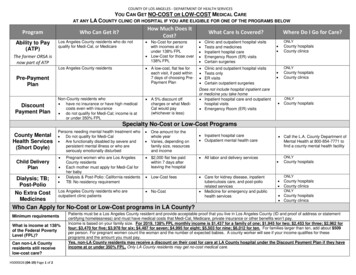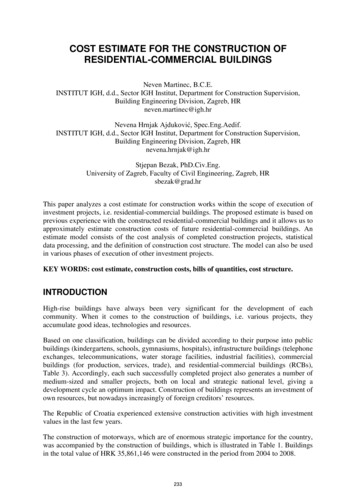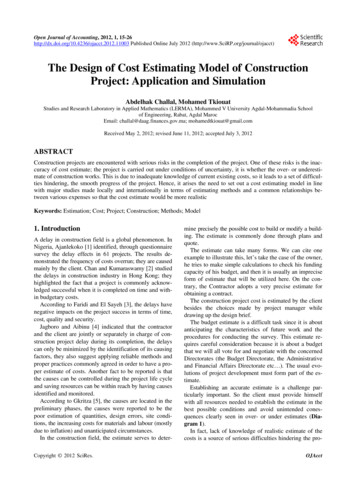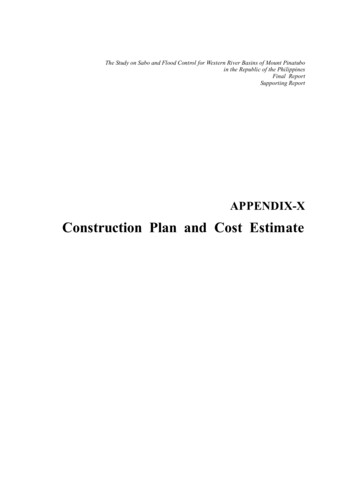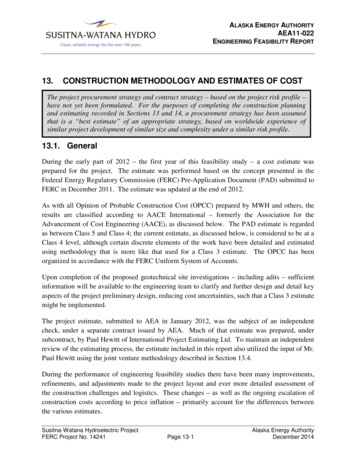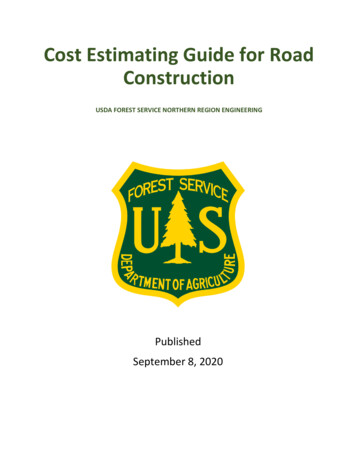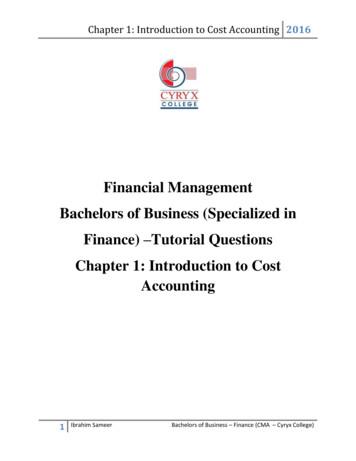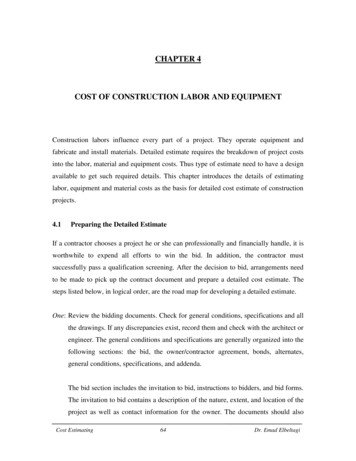
Transcription
CHAPTER 4COST OF CONSTRUCTION LABOR AND EQUIPMENTConstruction labors influence every part of a project. They operate equipment andfabricate and install materials. Detailed estimate requires the breakdown of project costsinto the labor, material and equipment costs. Thus type of estimate need to have a designavailable to get such required details. This chapter introduces the details of estimatinglabor, equipment and material costs as the basis for detailed cost estimate of constructionprojects.4.1Preparing the Detailed EstimateIf a contractor chooses a project he or she can professionally and financially handle, it isworthwhile to expend all efforts to win the bid. In addition, the contractor mustsuccessfully pass a qualification screening. After the decision to bid, arrangements needto be made to pick up the contract document and prepare a detailed cost estimate. Thesteps listed below, in logical order, are the road map for developing a detailed estimate.One: Review the bidding documents. Check for general conditions, specifications and allthe drawings. If any discrepancies exist, record them and check with the architect orengineer. The general conditions and specifications are generally organized into thefollowing sections: the bid, the owner/contractor agreement, bonds, alternates,general conditions, specifications, and addenda.The bid section includes the invitation to bid, instructions to bidders, and bid forms.The invitation to bid contains a description of the nature, extent, and location of theproject as well as contact information for the owner. The documents should alsoCost Estimating64Dr. Emad Elbeltagi
contain date, time and place that bids will be received; general contractor andsubcontractors’ prequalification requirements; date, time, and location of any prebid conference; availability of bidding documents with their dates, locations, andprocurement costs; and bond requirements.The owner/contractor agreement section is most often a “standard” document thatformalizes the construction contract price and construction duration. It should alsolist progress payments retained, percentage of completed work value, acceptanceconditions, and final payment constraints.The bond section should include bid bond and performance bond forms andrequirements. Bonds are written documents that describe the conditions andobligations related to the owner/contractor agreement. A bid bond certifies that if acontractor is awarded the bid within the time specified in the invitation to bid, thecontractor will enter into the contract and will provide all other required bonds in atimely manner. A performance bond guarantees the owner that within agreementlimits the contractor will perform all work in accordance with the contractingdocument. Labor and material bonds guarantee to the owner that the contractor willpay in a timely fashion for supplied materials used by all the subcontractors relatedto the project.Two: Review the drawings to visualize the building size, height, shape, function,basements, and so on. Start with floor plans, cross-sections, exterior finish system,and the roof. Note all unusual construction procedures, building systems, andmaterials that have been specified.Three: Review structural drawings to get acquainted with specified systems: reinforcedconcrete, structural steel, masonry, wood, or combinations. Find out which piecesof heavy construction equipment will be needed for erection and for how long. Payattention to various wall sections, materials and prefabricated assemblies.Four: Review mechanical, electrical, fire extinguisher, and security drawings. Record anypossible interference with substructure and superstructure erection.Cost Estimating65Dr. Emad Elbeltagi
Five: Start identifying work to be done by general contractor and work to be done bysubcontractors.Six: Read and study thoroughly the specifications for the work to be done by the generalcontractor and those related to any subcontracted work. Also, review generalconditions and note the items that will affect project costs.Seven: Visit the project site and have with you the project manager or field engineer.Eight: Call a meeting with the personnel who will hold the key supervisory positions.Establish with them the general guidelines for quantities take off and pricing.Nine: Develop a list of subcontractors. Notify subcontractors and suppliers that thecompany is preparing a proposal and ask if they intend to submit bids.Ten: Following the site visit and staff consultation, develop a list of items to beconsidered for jobsite overhead and general overhead that need to be priced later.Eleven: Start the quantities takeoff for the category of construction work selected to bedone in house (most often site work, foundations, and concrete work). When takingoff quantities, break each item down by size, type of material, and workmanship.Also list the type of construction equipment needed for each phase.Twelve: Condense quantities from the work up sheet by work category and transfer themto a summary sheet for pricing. Pricing means the cost of materials, labor, andconstruction equipment. The prices used are from company available cost filesadjusted to a particular location, or from quotes from suppliers and subcontractors.4.2Sources of Cost InformationNot all cost information has the same reputation for accuracy and reliability and careshould be exercised when choosing cost data for a new estimate. Cost informationrequired for pricing different work items may be gathered or compiled from differentsources.- Cost information from published price books such as US Means. Price books arepublished annually and contain a range of prices for standard bills of quantitiesitems.Cost Estimating66Dr. Emad Elbeltagi
- Priced bills of quantities from previous projects. A useful source of information asthe cost information tends to be current. As with other forms of cost data, there is aneed to adjust for differences in location, etc.- Cost analysis and cost models produced in-house. Depending on the size of anorganization, perhaps the most reliable source of cost information, partly due to thefact that it is easier to ensure good quality control on the data. Also data presentedin this format will be easily understood and interpreted. A disadvantage is the timeand cost taken to prepare and store the information.4.3Construction LaborIn today’s fast-paced industrialized age, where many of the products we see areincreasingly being mass produced in factories by machines, a building still remains asone of the few handcrafted products put together piece by piece by craftsmen. Theconstruction industry, to which these craftsmen belong, is one of the most labor-intensiveindustries in the world. The labor cost component of a building project often ranges from30 to 50%, and can be as high as 60% of the overall project cost. Therefore, it is clear thatconstruction labor is a vital component of a construction project.A building is a very complex product, made up of many different systems, such as thestructural system, exterior enclosure system, and HVAC system. These systems can bebroken down into many more subsystems and sub-subsystems. In this way, a buildingconstruction project is divided into numerous work packages. These work packages canthen be assigned to and completed by an individual worker or a crew. A crew is a team ofworkers, which can be of the same trade or a composite of many different trades. Due tothe diverse nature of the different tasks associated with all the building systems, manytypes of craftsmen from many different trades are required in a building constructionproject.4.3.1Labor s production rates (Productivity)A production rate is defined as the number of units of work produced by a person in aCost Estimating67Dr. Emad Elbeltagi
specified time. Production rates may also specify the time in man-hours or man-daysrequired to produce a specified number of units of work. The time that a labor willconsume in performing a unit of work varies between labors and between projects andwith climatic conditions, job supervision, complexities of the operation and other factors.It requires more time for erect shutters for stairs than for foundations.Sometimes, the production rate is replaced by the term productivity. In the most generalsense, productivity is the ratio of input versus the respective output. In construction, theinput is often the work hours of a worker or a crew, such as the 8 hours of a bricklayer.The output is the amount of work produced, such as laying 500 bricks. Thus constructionproductivity is defined as the quantity of work produced in a given amount of time by aworker or a specific crew, that is, the quantity of construction output units produced in agiven amount of time or a unit time. The formula for productivity is presented in Eq. 4.1.Construction productivity quantity of work produced / time duration(4.1)Example 4.1If a bricklayer can lay 500 bricks in 8 hours, then, the associated constructionproductivity is 500 bricks divided by 8 hours, which is 62 bricks per bricklayer hour.Although most items associated with the monetary factor remain relatively constant overa short period of time, such as during the construction phase, productivity, on the otherhand, can fluctuate wildly. To accurately estimate productivity, an estimator not onlyneeds a good historical record, but a lot of experience.4.3.2Productivity sourcesProductivity rates can be determined from published sources such as Means’ BuildingConstruction Cost Data and Walker’s Building Estimator’s Reference Book. Figure 4.1illustrates an excerpt from Means.Cost Estimating68Dr. Emad Elbeltagi
Fig. 4.1: Excerpt form Means’ Building Construction Cost DataFor a line item, Means provides the crew types associated with that line as well as twoforms of productivity rate: the daily output (unit/day) and labor hours (hr/unit). Forexample, referring to Figure 4.1, for line 09210-100-0900, the daily output is 72.74 m2and the labor hours required for one m2 is 0.550 hours. The bare labor cost for the lineitem is 13.70/m2. Also, the crew type for this work is Crew J-1. With reference to Figure4.2, the excerpt from Means’ crew listing shows Crew J-1 as consisting of 3 plasterers, 2plasterer helpers, and 1 mixing machine.Fig. 4.2: Excerpt form Means’ Building Construction Cost Data: Crew J-1The labor hours per unit production are determined by dividing the total labor hours ofthe crew by the daily output. With reference to line 09210-100-0900 in Fig. 4.1 and CrewJ-1 in Fig. 4.2, Figure 4.3 shows the computation involved in determining the weightedwage rate for the crew and bare unit labor cost for the line item.Cost Estimating69Dr. Emad Elbeltagi
Fig. 4.3: Calculating crew rateIt is important to note the presentation of productivity in labor hours. By keeping theproductivity record in labor hours, the record is essentially normalized and is notsubjected to the variability in project locations and prevailing wage rates. In this way,unit labor costs for the contractor’s own operating region can be easily developed bymultiplying local wage rates including burden and fringe benefits by the productivityrate.Example 4.2A contractor determines that the unit productivity for painting a wall is 0.55 hour perm2. If the local wage rate including burden and fringe benefits is LE30 per hour, theunit labor cost becomes LE16.50 per m2. If the wage rate is LE20 per hour, the unitlabor cost becomes LE11 per m2. In addition, productivity performance betweenprojects can also be easily compared if contractors keep cost accounting records inman-hours.4.3.3Estimating work durationDetermining the total work duration for a task involves knowledge of the quantity ofwork required for the task and the production rate for the specific crew that will beperforming the work. The quantity of work associated with the material quantity isdetermined by the quantity take off discussed in Chapter 2. A straight forward approachto the estimation of activity durations is to keep historical records of particular activitiesand rely on the average durations from this experience in making new duration estimates.Since the scope of activities is unlikely to be identical between different projects, unitCost Estimating70Dr. Emad Elbeltagi
production rates are typically employed for this purpose. The duration of an activity maybe estimated as given in Eq. 4.2.Work duration quantity of work / number of crews production rate(4.2)Example 4.3Find the duration of an interior and exterior painting activities with quantities of 440m2 and 378 m2 respectively, using crews of 11 m2/hours and 14 m2/hours for theinterior and exterior painting activities respectively.SolutionInterior painting duration 440 / 11 40 hoursExterior painting duration 378 / 14 27 hoursTotal work hours 67 hoursTypically, the quantity of work is determined from engineering drawings of a specificproject. The number of crews working is decided by the planner. In many cases, thenumber or amount of resources applied to particular activities may be modified in light ofthe resulting project plan and schedule. Some estimate of the expected work productivitymust be provided. Historical records in a firm can also provide data for estimation ofproductivities.Having defined a duration of a given work, it means that the planner have already definedthe number of resources that will be employed in a particular work. Knowing durationand resources employed, it is simple to estimate the activity direct cost. Then, the threeelements of an activity: duration, cost, and resources form what is called constructionmethod. Some activities can be performed using different construction methods. Where,its method will have its own resources, cost and duration.4.3.4Basic principle for estimating labor costsLabor costs in construction are determined by two factors: monetary and productivity.The
Detailed estimate requires the breakdown of project costs into the labor, material and equipment costs. Thus type of estimate need to have a design available to get such required details. This chapter introduces the details of estimating labor, equipment and material costs as the basis for detailed cost estimate of construction projects. 4.1 Preparing the Detailed Estimate If a contractor .


